Di default, la maggior parte dei temi per WordPress ha un disclaimer generico nel footer, ma questo può far sembrare il sito poco professionale. Inoltre, lascia meno spazio per i vostri link, le note di copyright e altri contenuti.
Sia che vogliate ridurre il footer o aggiungere il vostro brand, la rimozione del credito predefinito di WordPress è semplice e migliora l’aspetto generale del vostro sito.
Grazie alla nostra vasta esperienza nella costruzione di siti web WordPress, abbiamo riconosciuto l’importanza di mantenere la coerenza del brand. Ecco perché abbiamo strategicamente rimosso il link “powered by WordPress” dal footer dei nostri siti, compresi WPBeginner, WPForms e MonsterInsights.
In questo articolo vi mostreremo come rimuovere facilmente anche i link del footer “powered by WordPress”.
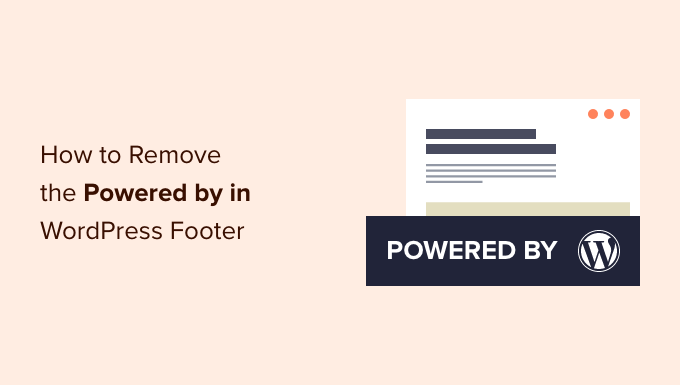
Perché rimuovere i crediti nel piè di pagina di WordPress?
Molti temi WordPress mostrano una clausola di esclusione di responsabilità “Proudly powered by WordPress” nel piè di pagina del loro sito web, che rimanda al sito ufficiale WordPress.org.
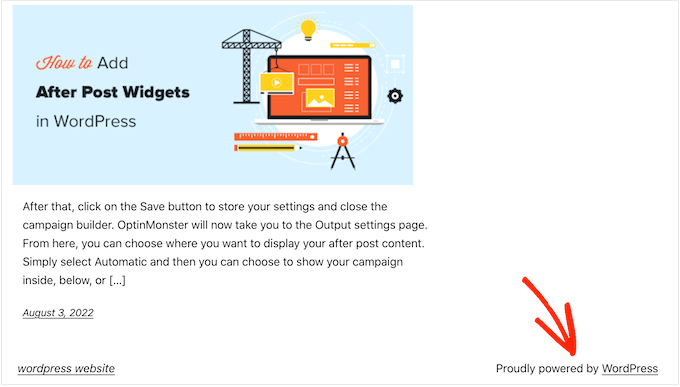
Alcuni sviluppatori di temi si spingono oltre e aggiungono i propri crediti nel piè di pagina.
Nell’immagine seguente, è possibile vedere il disclaimer aggiunto dal tema Astra WordPress.
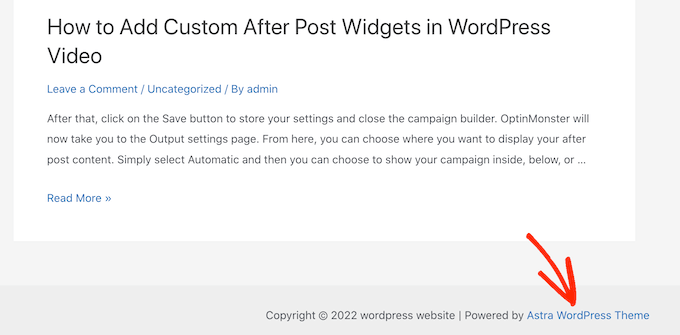
Sebbene sia ottimo per gli sviluppatori di software, questo piè di pagina “Powered by….” può far sembrare il vostro sito meno professionale, soprattutto se gestite un sito aziendale.
Inoltre, consente agli hacker di sapere che state utilizzando WordPress, il che potrebbe aiutarli a penetrare nel vostro sito. Ad esempio, se non utilizzate un URL di accesso personalizzato, gli hacker possono semplicemente aggiungere /wp-admin all’indirizzo del vostro sito e raggiungere la pagina di accesso.
Questo disclaimer rimanda inoltre a un sito esterno, incoraggiando le persone a lasciare il vostro sito web. Questo può avere un impatto negativo sulle pagine viste e sulla frequenza di rimbalzo.
È legale rimuovere i link di credito del piè di pagina di WordPress?
La rimozione del link ai crediti a piè di pagina sul vostro sito è perfettamente legale perché WordPress è gratuito e rilasciato sotto licenza GPL.
In sostanza, questa licenza vi dà la libertà di usare, modificare e persino distribuire WordPress ad altre persone.
Ogni plugin o tema di WordPress scaricato dalla directory ufficiale di WordPress è rilasciato sotto la stessa licenza GPL. Anche la maggior parte dei plugin e dei temi commerciali sono rilasciati sotto licenza GPL.
Ciò significa che siete liberi di personalizzare WordPress in qualsiasi modo, compresa la rimozione dei crediti a piè di pagina dal vostro sito web aziendale, negozio online o blog.
Tenendo conto di ciò, vediamo come rimuovere i link a piè di pagina “powered by WordPress”.
Video tutorial
Se non volete il video o avete bisogno di ulteriori istruzioni, utilizzate i link rapidi qui sotto per passare direttamente al metodo che desiderate utilizzare:
Metodo 1: Usare le impostazioni del tema (facile e veloce)
La maggior parte dei bravi autori di temi sa che gli utenti desiderano avere la possibilità di modificare il piè di pagina e rimuovere i link ai crediti, quindi molti la includono nelle impostazioni del tema.
Per verificare se il vostro tema dispone di questa opzione, andate su Aspetto ” Personalizza nella dashboard di amministrazione di WordPress.
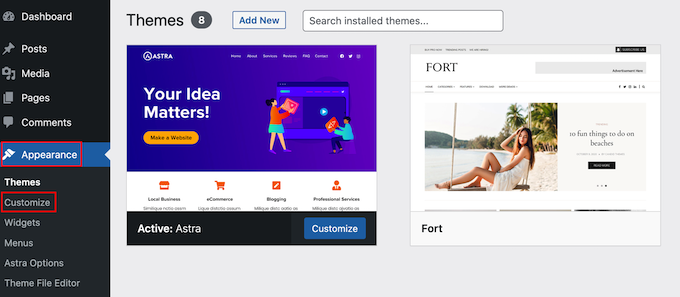
Si aprirà il personalizzatore del tema, dove è possibile cercare le impostazioni che consentono di personalizzare il piè di pagina del sito.
Ad esempio, il tema Astra ha una sezione chiamata “Footer Builder”.
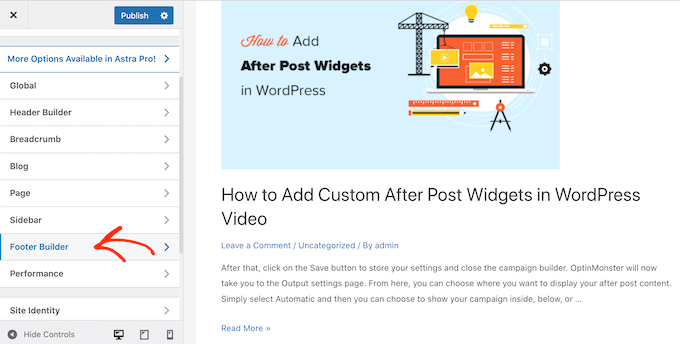
Se si utilizza questo tema, è sufficiente fare clic sulla sezione “Piè di pagina” e selezionare “Copyright”.
Si apre un piccolo editor in cui è possibile modificare il testo del piè di pagina o addirittura eliminarlo completamente.
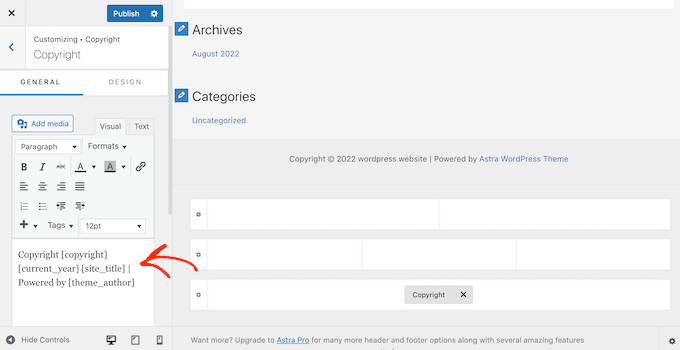
Indipendentemente dal modo in cui si rimuove la clausola di esclusione della responsabilità a piè di pagina, non dimenticate di cliccare su “Pubblica” per rendere effettiva la modifica sul vostro sito.
Metodo 2: utilizzare l’editor completo del sito (funziona con i temi basati su blocchi)
Se si utilizza un tema WordPress abilitato ai blocchi, è possibile rimuovere il disclaimer a piè di pagina utilizzando la funzione Full Site Editing (FSE).
Questo è un modo semplice e veloce per rimuovere il credito “Powered by” dall’intero sito, anche se non funziona con tutti i temi.
Per lanciare l’editor, andare su Aspetto “ Editor.
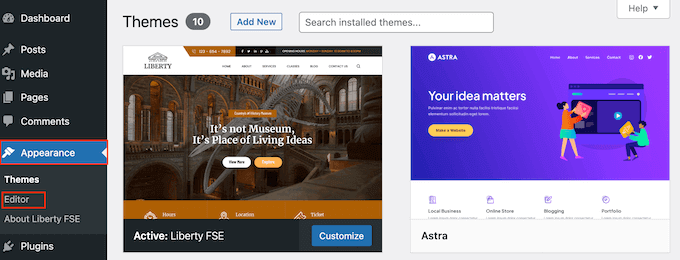
Per impostazione predefinita, l’editor completo del sito mostra il modello di home del tema.
Nel menu di sinistra, selezionare “Modelli”.
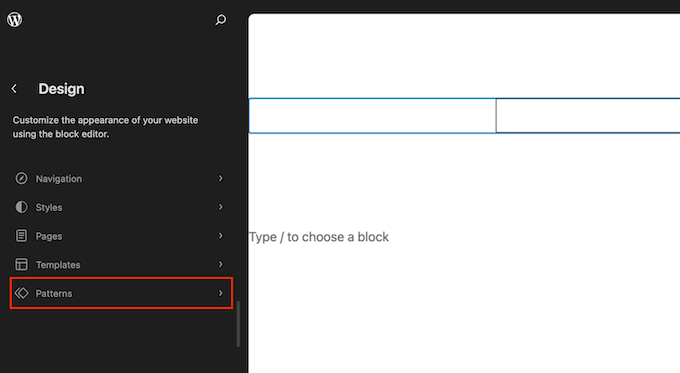
Questo mostra un elenco di tutti i modelli e le parti di modello che compongono il vostro tema WordPress. Sotto “Parti del modello”, fare clic su “Piè di pagina”.
Mostra una miniatura del piè di pagina del sito web. Per vedere il piè di pagina, fare clic sull’anteprima.
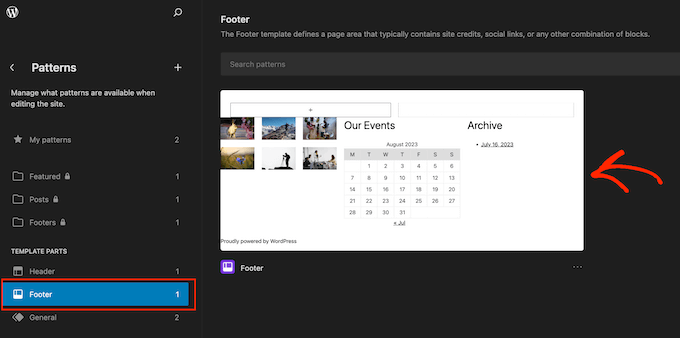
Ora si vedrà un’anteprima del modello del tema.
Per modificare il piè di pagina, fare clic sull’icona della matita.
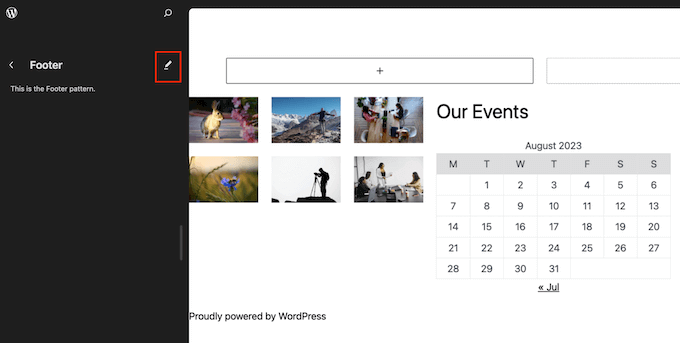
Quindi, selezionare l’esclusione di responsabilità “Powered by”.
Ora è possibile sostituirlo con un contenuto proprio o eliminare la clausola di esclusione della responsabilità.
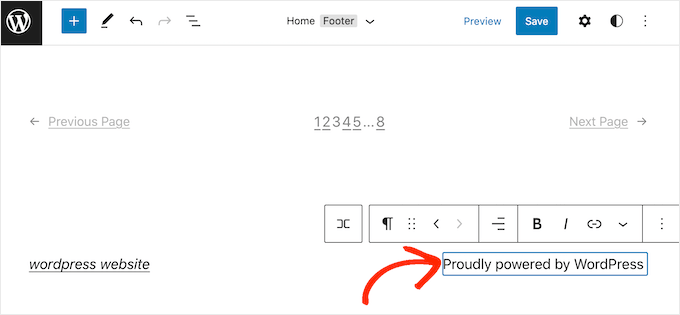
Quando si è soddisfatti dell’aspetto del piè di pagina, è sufficiente fare clic su “Salva”. Ora, se visitate il vostro sito, vedrete la modifica dal vivo.
Metodo 3: come rimuovere la dicitura “Powered by” utilizzando un costruttore di pagine
Molti siti web WordPress utilizzano il piè di pagina per comunicare informazioni importanti come l’indirizzo e-mail o il numero di telefono. In effetti, i visitatori potrebbero scorrere fino in fondo al vostro sito solo per cercare questi contenuti.
Per questo motivo, potreste fare un ulteriore passo avanti e sostituire il testo “Powered by” con un piè di pagina personalizzato. Questo piè di pagina potrebbe contenere link ai vostri profili sui social media, link ai vostri partner di marketing affiliato, un elenco dei vostri prodotti o altre informazioni e link importanti.
Ecco come utilizziamo l’area del piè di pagina su WPBeginner:
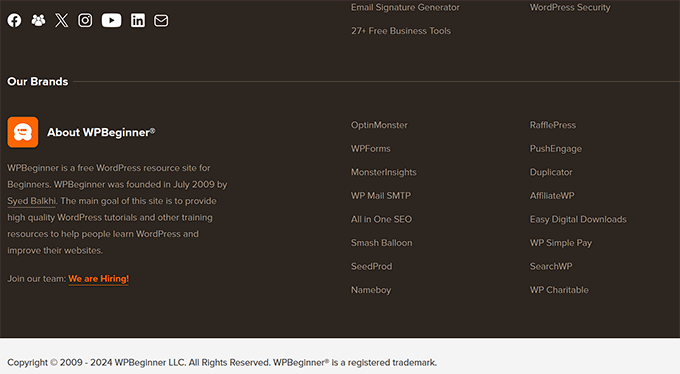
Il modo migliore per creare un footer personalizzato è utilizzare SeedProd. È il miglior plugin per il builder di pagine ed è dotato di 100 template, sezioni e blocchi progettati in modo professionale che possono aiutarvi a personalizzare ogni parte del vostro sito web.
Dispone inoltre di impostazioni che consentono di creare un piè di pagina globale, una barra laterale, un’intestazione e altro ancora.
Per prima cosa, è necessario installare e attivare SeedProd. Per maggiori dettagli, consultate la nostra guida passo passo su come installare un plugin di WordPress.
Nota: esiste anche una versione gratuita di SeedProd che consente di creare tutti i tipi di pagine utilizzando l’editor trascina e rilascia, compresa una pagina personalizzata per la modalità di manutenzione. Tuttavia, utilizzeremo la versione premium di SeedProd, poiché è dotata di un avanzato builder del tema.
Dopo aver attivato il plugin, SeedProd chiederà la chiave di licenza.

Queste informazioni si trovano nel proprio account sul sito web di SeedProd. Dopo aver inserito la chiave, fare clic sul pulsante “Verifica chiave”.
Una volta fatto ciò, andare su SeedProd ” Theme Builder. Qui, fare clic sul pulsante “Aggiungi nuovo modello di tema”.
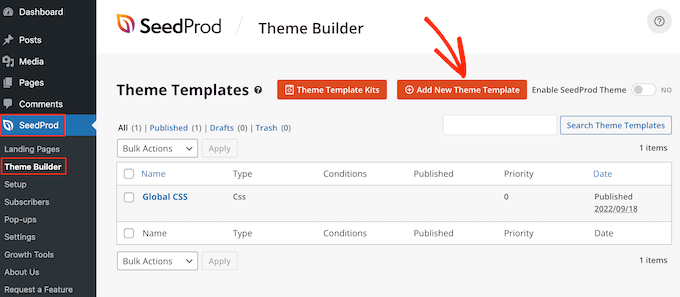
Suggerimento: SeedProd dispone anche di una libreria crescente di kit di siti web professionali che potete utilizzare come base per il vostro tema personalizzato. Per maggiori informazioni, consultate la nostra guida su come installare i kit di modelli in WordPress.
Nel popup, digitare un nome per il nuovo modello di tema.
Una volta fatto ciò, aprire il menu a tendina “Tipo” e scegliere “Piè di pagina”.
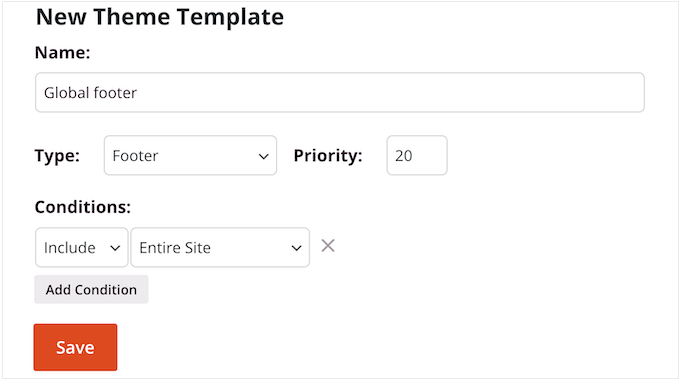
SeedProd mostrerà il nuovo modello di piè di pagina su tutto il sito per impostazione predefinita. Tuttavia, è possibile limitarlo a pagine o post specifici utilizzando le impostazioni “Condizioni”.
Ad esempio, potreste voler escludere il nuovo footer dalle vostre pagine di destinazione, in modo che non distragga dalla vostra call to action principale.
Quando siete soddisfatti delle informazioni inserite, fate clic su “Salva”. In questo modo verrà caricata l’interfaccia del costruttore di pagine SeedProd.
All’inizio, il modello mostrerà una schermata vuota sulla destra e le impostazioni sulla sinistra. Per iniziare, fare clic sull’icona “Aggiungi colonne”.
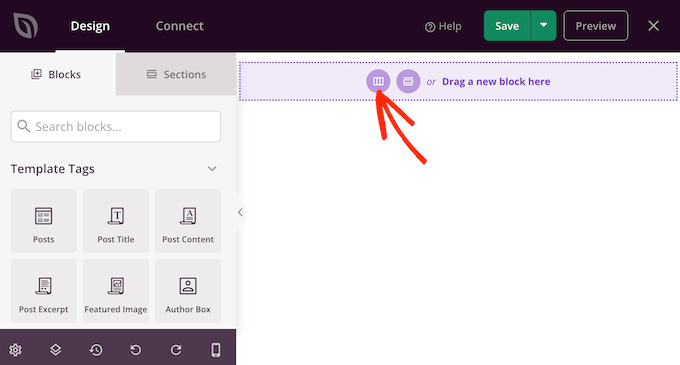
È ora possibile scegliere il layout da utilizzare per il piè di pagina. Ciò consente di organizzare i contenuti in diverse colonne. Ad esempio, si possono visualizzare i widget di WordPress in colonne.
È possibile utilizzare qualsiasi layout, ma noi utilizziamo un layout a tre colonne per tutte le nostre immagini.
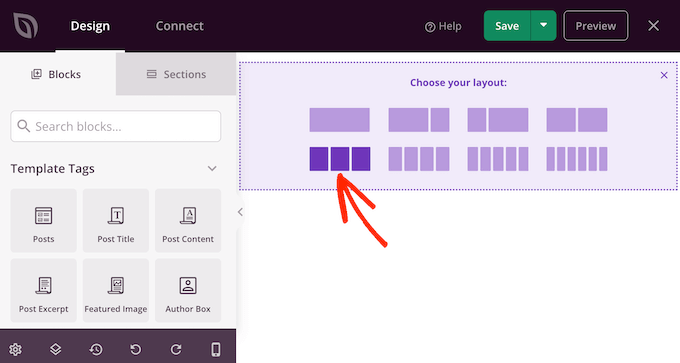
Successivamente, è possibile modificare lo sfondo del piè di pagina in modo che si adatti al tema di WordPress, al marchio aziendale o al logo.
Per modificare il colore dello sfondo, è sufficiente fare clic sulla sezione accanto a “Colore di sfondo” e utilizzare i controlli per scegliere un nuovo colore.
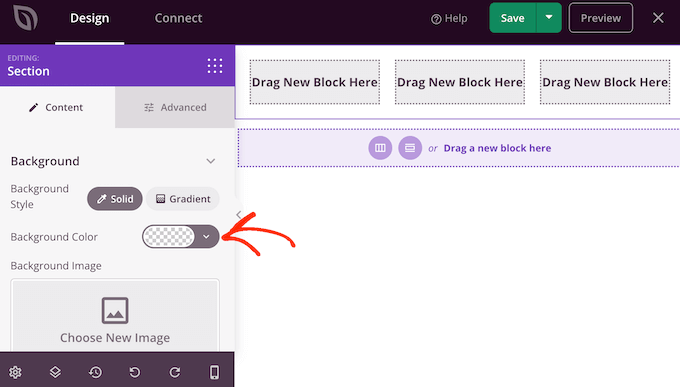
Un’altra opzione è quella di aggiungere un’immagine di sfondo.
A tal fine, fare clic su “Usa la tua immagine” e scegliere un’immagine dalla libreria multimediale di WordPress oppure fare clic su “Usa un’immagine stock”.

Quando si è soddisfatti dello sfondo, è il momento di aggiungere del contenuto al piè di pagina.
È sufficiente trascinare un blocco qualsiasi dal menu di sinistra e rilasciarlo nel piè di pagina.
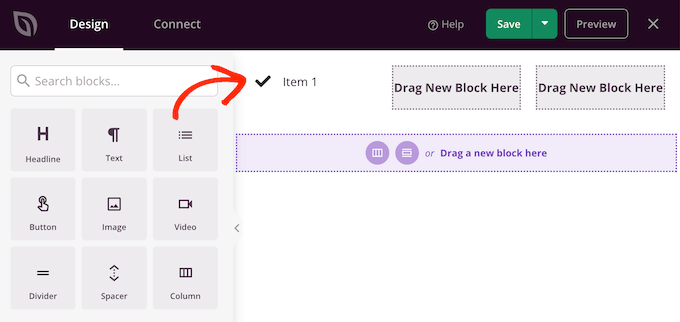
Dopo aver aggiunto un blocco, fare clic per selezionarlo nell’editor principale.
Il menu di sinistra mostra ora tutte le impostazioni che si possono utilizzare per personalizzare il blocco.
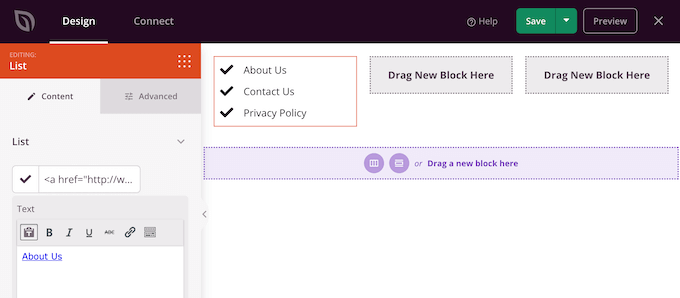
Basta ripetere questi passaggi per aggiungere altri blocchi al piè di pagina. Se non siete sicuri di quali blocchi utilizzare, può essere utile consultare la nostra lista di controllo delle cose da aggiungere al piè di pagina del vostro sito WordPress.
È inoltre possibile modificare la posizione di ciascun blocco trascinandolo nel layout.
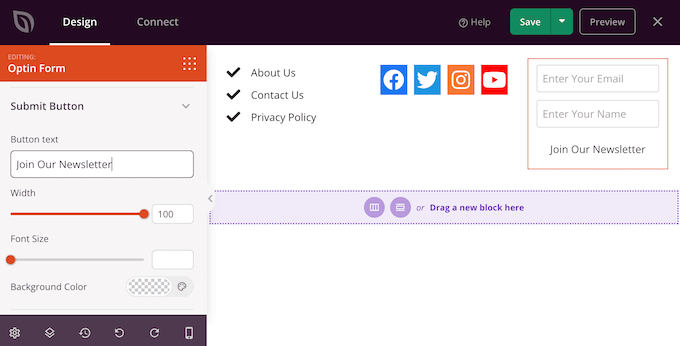
Quando siete soddisfatti del vostro progetto, fate clic sul pulsante “Salva”.
Quindi, è possibile selezionare “Pubblica” per completare il progetto.
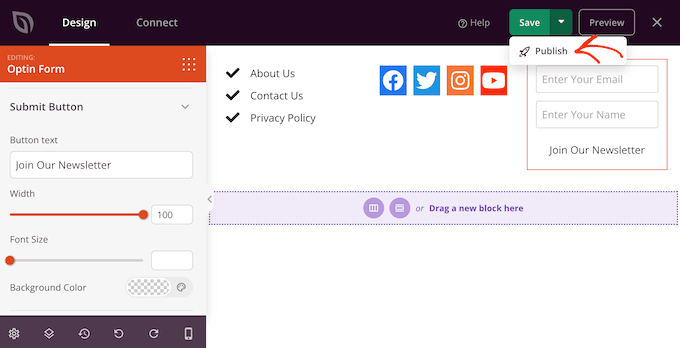
Per rendere attivo il nuovo piè di pagina sul vostro blog WordPress, dovrete completare la creazione del vostro tema WordPress con SeedProd. Per istruzioni passo passo, consultate la nostra guida su come creare un tema WordPress personalizzato.
Dopo aver creato il tema, andare su SeedProd ” Costruttore di temi. Quindi, fare clic sull’interruttore “Abilita tema SeedProd”.
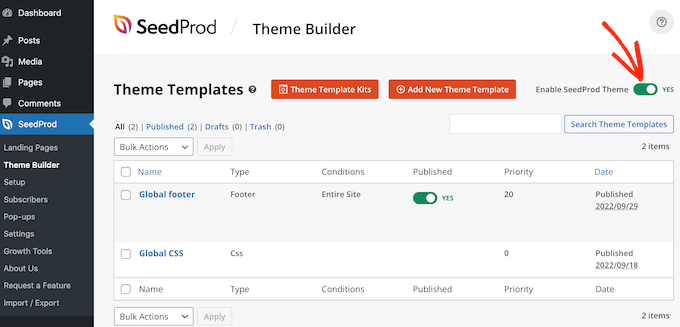
Ora, se visitate il vostro sito web, vedrete il nuovo footer dal vivo.
Metodo 4: Rimozione della clausola di esclusione di responsabilità di WordPress tramite codice
Se non si vede alcun modo per rimuovere o modificare i crediti del piè di pagina nel personalizzatore di WordPress, si può sempre modificare il codice footer.php.
Questo non è il metodo più semplice per i principianti, ma vi permetterà di rimuovere il credito da qualsiasi tema WordPress.
Prima di apportare modifiche al codice del vostro sito web, vi consigliamo di creare un backup per poterlo ripristinare in caso di problemi.
Tenete presente che se modificate direttamente i file del vostro tema WordPress, queste modifiche scompariranno quando aggiornerete il tema. Per questo motivo, si consiglia di creare un tema figlio, che consente di aggiornare il tema WordPress senza perdere la personalizzazione.
Per prima cosa, dovete collegarvi al vostro sito WordPress utilizzando un client FTP come FileZilla, oppure potete utilizzare un file manager fornito dalla vostra società di hosting WordPress.
Se è la prima volta che utilizzate l’FTP, potete consultare la nostra guida completa su come connettersi al vostro sito utilizzando l’FTP.
Una volta collegati al sito, andare in /wp-content/themes/ e aprire la cartella del tema corrente o del tema figlio.
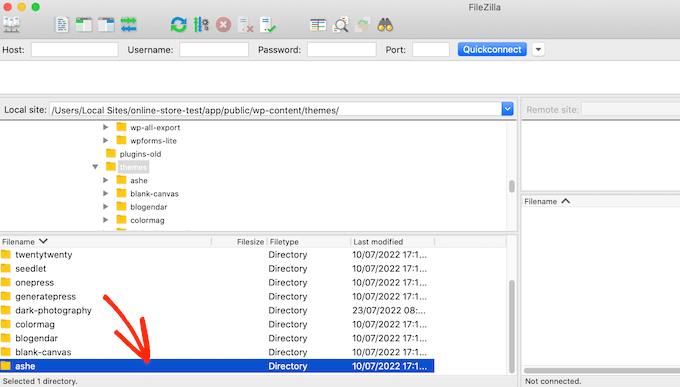
All’interno di questa cartella, trovare il file footer.php e aprirlo in un editor di testo come Notepad.
Nell’editor di testo, cercate una sezione di codice che includa il testo “powered by”. Ad esempio, nel tema Twenty Twenty-One per WordPress, il codice ha questo aspetto:
<div class="powered-by">
<?php
printf(
/* translators: %s: WordPress. */
esc_html__( 'Proudly powered by %s.', 'twentytwentyone' ),
'<a href="' . esc_attr__( 'https://wordpress.org/', 'twentytwentyone' ) . '">WordPress</a>'
);
?>
</div><!-- .powered-by -->
È possibile eliminare completamente questo codice o personalizzarlo in base alle proprie esigenze.
Ad esempio, si potrebbe sostituire la dicitura “Proudly powered…” con la propria nota di copyright.
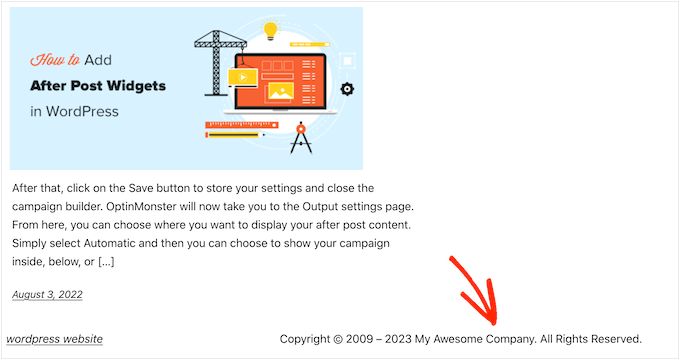
Dopo aver apportato le modifiche, salvare il file e caricarlo sul server. Se si controlla il sito, il credito a piè di pagina sarà scomparso.
Attenzione! Evitate a tutti i costi il metodo CSS!
Alcuni siti di tutorial di WordPress possono mostrare un metodo CSS che utilizza display: none per nascondere i link di credito a piè di pagina.
Sebbene questo sembri semplice, è molto dannoso per la SEO di WordPress.
Molti spammer utilizzano proprio questa tecnica per nascondere i link ai visitatori, pur mostrandoli a Google nella speranza di ottenere un posizionamento più alto.
Se nascondete il credito del footer con i CSS, Google potrebbe segnalarvi come spammer e il vostro sito perderebbe posizioni nei motori di ricerca. Nel peggiore dei casi, Google potrebbe addirittura cancellare il vostro sito dal suo indice, in modo che non appaia mai nei risultati di ricerca.
Vi consigliamo invece di utilizzare uno degli altri metodi che abbiamo illustrato sopra. Se non potete utilizzare nessuno di questi metodi, un’altra opzione è quella di assumere uno sviluppatore di WordPress che rimuova il credito a piè di pagina per voi, oppure potreste cambiare il vostro tema WordPress.
Speriamo che questo articolo vi abbia aiutato a rimuovere i link del footer “powered by WordPress”. Potreste anche voler selezionare il nostro tutorial su come correggere il problema della barra di amministrazione mancante in WordPress e il nostro elenco di consigli vitali per proteggere l’area di amministrazione di WordPress.
Se questo articolo vi è piaciuto, iscrivetevi al nostro canale YouTube per le esercitazioni video su WordPress. Potete trovarci anche su Twitter e Facebook.





Dennis Muthomi
One question – is there a code snippet that can automatically update the copyright year when a new year begins?
well currently, I have to manually change it to the new year on January 1st every year. Having it update automatically would save me that step.
WPBeginner Comments
We happen to have a guide for this here: https://www.wpbeginner.com/wp-tutorials/how-to-add-a-dynamic-copyright-date-in-wordpress-footer/
Dennis Muthomi
Thank you for the guide, I’ll definitely implement it on my websites
Casmat tiskey
I dont have the footer.php file in my themes… can’t do any other method
WPBeginner Support
If you don’t have a footer.php, reach out to your theme’s support to see if they have a custom location for the footer.
Admin
Neale
I had the same problem but ur site’s version is not the same as mine, so I couldn’t remove the Powered by WordPress footer this happend to me in other site’s too
WPBeginner Support
Not all themes have the same options which is why we have multiple options in this guide. If the methods in this guide were unable to help you then we would recommend reaching out to your specific theme’s support and they should be able to assist.
Admin
Kate Sullivan
This was so helpful and exactly what was needed! Thank you for making it so simple! Kate
WPBeginner Support
You’re welcome
Admin
Arun Das
Such a detailed article, This is very useful for me. Thanks for the great information.
WPBeginner Support
You’re welcome, glad our guide could be helpful
Admin
Ibrahim
Thank you for the post.it’s very helpful.
WPBeginner Support
You’re welcome, glad you found our post helpful
Admin
JACK
this is help me so much in my learning Thank you for sharing
WPBeginner Support
You’re welcome, glad our guide was helpful
Admin
Boniface
Thanks for your article on this topic. I find it very helpful. I really appreciate your effort.
WPBeginner Support
You’re welcome, glad you liked our article
Admin
Candy
I’m using my theme template & footer.php is missing & footer remove credits are not working What to do?
What to do?
WPBeginner Support
You would want to reach out to the support for your specific theme and they should be able to assist you.
Admin
Sandra Sakura
how do I move:
~~
My Website
This is Visualize, a responsive site template designed by SitePad and is available with SitePad Website Builder.
~~
to the bottom so it’s not so prominent … I would like people to think it’s my website not SitePad.
WPBeginner Support
You would want to check under Settings>General to ensure your title and tagline are not that and if not then you would check under Appearance>Customize
Admin
Dave
Thanks for this tutorial. Mine was a bit different, but your video helped me find it. In the footer.php file, I commented out this line and it removed the “powered by WordPress” footer:
get_template_part( ‘template-parts/footer/site’, ‘info’ );
WPBeginner Support
Thanks for sharing what worked for you
Admin
Kevin
Hi,
When I tried to remove I got the following message.
Unable to communicate back with site to check for fatal errors, so the PHP change was reverted. You will need to upload your PHP file change by some other means, such as by using SFTP.
I’m currently using localhost on XAMPP on my laptop.
Please I kindly need your help.
WPBeginner Support
That means WordPress could not verify that the code change would not cause a problem so you would manually need to edit the file for that change to take effect.
Admin
Atif Khawaja
hello!
Its been a great experience for me as a beginner of Word Press to learn and find solutions of my problems through the platform of WPBeginner. These days i have been facing the same problem as stated above i have watched all the videos related to this issue on this platform but it didn’t work for me, I am using word press theme Shop Elite in this theme there is an option to edit half of the footer but credit link remains,I have tried all methods you have suggested also tried some plugins like (Real time find and Replace, My Custom Function), Please look into this issue.
I will wait for your kind response,
Thank You!
WPBeginner Support
If you reach out to the support for your specific theme they should be able to let you know what theme specific setting could be preventing you from removing that credit
Admin
Adrian
Thanks! Very useful
WPBeginner Support
You’re welcome
Admin
George Oluwole
I tried to remove the powered by message and I got the following in return: omething went wrong. Your change may not have been saved. Please try again. There is also a chance that you may need to manually fix and upload the file over FTP. Maybe I didn’t know exactly what to remove. Please I need help.
WPBeginner Support
The editor in WordPress itself had a recent update to check for errors before allowing a file to be changed. That message means it couldn’t be sure it wouldn’t cause an error so it canceled the edit which means you would need to use your host’s file manager or FTP to edit the file.
It’s not saying you tried to remove the wrong code.
Admin
Adimas Putra
I am really happy to glad at this blog posts which carries tons of useful facts,
thanks for providing these kinds of data.
WPBeginner Support
Glad you find our content helpful
Admin
Roshni
Thank you, for this useful info.
In the Charity Care theme (child theme of Benevolent) footer is found at the bottom of the Functions.php page
(path wp=content => themes => charity-care => functions.php)
When I had contacted the theme support, they suggested to use #site-info {display:none}
WPBeginner Support
Thanks for sharing that for other readers
Admin
Lauri Crosley
Wonderful goods from you, man. I’ve be aware your stuff prior to and you are simply extremely fantastic. I actually like what you have bought here, certainly like what you’re saying and the way in which wherein you say it. You’re making it entertaining and you continue to care for to keep it sensible. I can’t wait to learn far more from you. This is really a tremendous site.
WPBeginner Support
Glad you’re enjoying our content and finding it helpful
Admin
Sekh Sahajahan
My sidebar is showing under my post body. How to take it back to the side.
Currently running on news pro Genesis child theme
WPBeginner Support
You may want to ensure your browser window is wide enough for it to go on the side of your content. If it continues to be below your content you would want to reach out to the theme’s support for them to assist.
Admin
Chukwu Sunday
Please how do I make the copy right change in highlight WordPress theme sir.
WPBeginner Support
You would first want to reach out to the theme’s specific support for if there is a built-in or recommended method for changing the copyright text.
Admin
shahab uddin
I am very please to read this. It is very helpful.
romanregions
thanks for Be that as it may, I like this connection fueled by WordPress. So I would prefer not to expel controlled by WordPress joins from my footer. Your article will be useful how need expel that connections from footer. A debt of gratitude is in order for sharing.
Hamza
hey dear how are you today
i have a WP site and i want to show results online by searching roll number.
i don’t want to upload result in my data base.
i have more then 10,00,000 results in excel sheet.
i want a code that get result from google sheet searching in column and show result by matching row.
thanks
Maliha khan
it is very helpful for all of us. thanks!
Simon
Actually damaged my website trying to follow the instructions in the php footer removal. Think I have to reinstall my theme now. I’m neither a programmer nor an idiot. But something in these instructions missed the mark.
Anon
Numer 1 rule of webdesign/programming: Always back up any file/files your working on, then if you make a mistake and can’t figure out where you went wrong you can simply overwrite and start again.
Preok
Yep, backing up is a MUST if you’re going to edit. #BestPractice
Harry
thanks for your nice information, but i think “Footer.php Code Method” is hard for non programmer like me.
Jeff
Is there a way to remove the Remove the Powered by WordPress with a Code Snippet?
Rizwan Ali
When i try to remove footer or change footer then my theme disturb i.e crash or does not work properly. what to do?
Maxwell
Usually it’s because you removed something vital like ‘ ‘, you only supposed to remove text inside the inverted commas. If you using a text editor with syntax highlighting it’ll be easier to figure out, another option will be to remove one word at a time and check if it’s successful
tony
what’s the benefit from removing it?
Qureshi Khan
I can not remove it from my blog
Mark Phelps
Too bad we can’t editor our comments. Now what, now what, now what!
kyle
If you just eliminate every footer tag, and div and what not. is that sufficient?
Mati
Hello,
I have question. I have theme Ultimate and I try try try delete footer links Powered by: WordPress and Theme by: Themehorse.
I created child theme, I tried delete footer by using different codes but my action lost. I haven’t idea.
I know that this footer is invisible because the footer link is hide in “container” i think… I am green in programming :).
Please help,
Mati
Ehtisham
Hi, Wpbeginner , I have found a new method to delete “Powered by Name”
Just go to Appearance >>Editor and try to find footer.php (it’ll be on the right side under theme option)
Simply edit it’s powered by phase , update it and it’ll be removed
Ehtisham
Hi there , My theme is showing this at it’s footer
” WordPress Theme by MH Themes”
I’ve tried to find it’s code in footer.php even in functions and from every page as much i can see .But i’m unable to remove it.
I hope you have better solution for this..
Thanks
Heinrich
I’m having the same problem. Looked at many other files but can’t find where to remove it.
Tanagi
for all others who did not managed to edit their “powered” text , simply put the whole theme folder into an editing software like notepad++ and do a search for the term ” .site-info ” without the “” symbols. once you found the php section ,change the tag’s to whatever you want .
if you didnt find “.site-info” or it didnt change , probably your theme has already done it and changed its name , to find the new term for the search :
1. enter your website as a user using a chrome browser
2. right click on the credit text
3. choose inspect
4. the opened editor will show you the “tag” name replaced for .site-info
now, go back and commit a search on the theme folder
hope that helps
Linda
Very helpful, but the php page varies per theme. I found this text in Function.php in the Theme Astrid.
Georges
Thank you,
You Rock!
Paul
I have removed the code from the twenty sixteen theme for WordPress and the code still appears at the bottom of my page. Please advise me what to do. I use store theme
Paul
Hi, I use accesspress store and I’ve remove this default Twenty Sixteen theme for WordPress, the code looks like this entirely and the WordPress branding still shows at my footer, please what do I do?
01
02
10
<a href="” rel=”home”>
11
<a href="”>
12
WPBeginner Support
Hey Paul,
When copying the code you have copied the line numbers as well.
You will see a tiny Copy button at the top right corner of the code snippet. Click on it and you will see the raw code without line numbers.
Admin
Fajar
I just success in modifying footer.php via cPanel. But how about any theme upgrade in the next ?. Should the original link will appear again ?
Nick Hyatt
Fajar, if you have not created a Child Theme, then you are correct. As soon as the theme is updated, your customization of the footer.php file will be obliterated by the new version of the file.
I would recommend always creating a child theme for any project you are working on so that you don’t have to go back and redo changes previously made.
manas
How to remove footer credits in one press single page theme ??
jack
its very useful …..
Andrew
I use Fluida theme and found the “Powered by” text in the core.php file.
If you’re a beginner, it can be dangerous poking around in these files, as you can easily break stuff. So here’s how I found the line of text, and a safe way to get rid of it.
Download Notepad++. It’s freeware, and it’s awesome.
I downloaded a fresh, zipped version of my theme and unzipped everything into a folder.
Open Notepad++
Under the Search menu, there’s an option to Search in Files. choose this.
Then enter the text “powered by” (or whatever variation you’re after), choose the directory you just unzipped the theme into, then search.
As I said, I found it in core.php. Notepad++ tells me it was on line 208.
Go to the Editor section of WP, find the file (core.php in my case). Copy it all, and paste it into a blank Notepad++ doc. Go to line 208.
Don’t delete anything. Instead, comment out the lines you want to hide. Do this by adding // to the start of the line/s that contain the html code for the part of the footer you don’t want.
Here’s what mine looks like after I’ve added the // to the appropriate lines.
You can see these lines contain the “powered by” as well as the opening and closing of the links to WordPress. The line I left in is my copyright info, which I still want to show up.
It’s also important that you don’t try to comment out the whole section. This can break wordpress.
Hope this helps someone.
Leah
THANK YOU, Andrew! This was exactly what I needed. I didn’t end up needing Notepad thanks to your description of which php file to find it in and how to comment it out! I’m running a child theme and have been poking around for awhile trying to figure it out! Thanks again!
Pawan
Thank you very much man finally I got the solution. I was searching this from 3 days and you fixed it in 10 minutes. Thank you Again. God bless you.
Pawan.
WPBeginner Support
Hey Pawan,
Glad you found it useful Don’t forget to follow us on Facebook for more WordPress tips and tutorials.
Don’t forget to follow us on Facebook for more WordPress tips and tutorials.
Admin
Ann
Thanks for this. I tried it but it doesn’t seem to work with the Rara Perfect Portfolio theme that I’m using. I get no hits at all.
I’ve also searched the them files in my C Panel with the same results. I can see the code if I use Chrome Inspect on the web page, but it seems to be hidden somehow in the files.
Any ideas please?
Annabel
This doesn’t help me either. I don’t have the text within the footer.php file. I want to use Amadeus but can’t remove the text.
Any ideas?
(ps great tutorial)
Jean Corson
I don’t understand half of what is being said on these answers, I am no techie I want completely off this site Help
Carl Duran
I don’t think so this feature is found in all themes directly from customization area?
BTW great post.
YOGESH
HELLO wpbeginner,
i am using clear commerce theme of wordpress how can i remove theme credit in which content “Clean Commerce by WEN Themes”,
please help !!!!
WPBeginner Support
Hi Yogesh,
Please contact your theme developer to learn how to do that safely without breaking your site.
Admin
Joe
Why remove teh Powered By WordPress link.?
It’s free software, and if you use it the least you can do is promote it.
Jual beli rumah
Its so helpful
david
it work fine, but i hope it will not affect the template, thanks for the info
Saad
No way to remove footer from customizer theme.
Footer.php
<footer id="footer" class="”>
Saad
Was not able to add full footer code due to limit on comments.